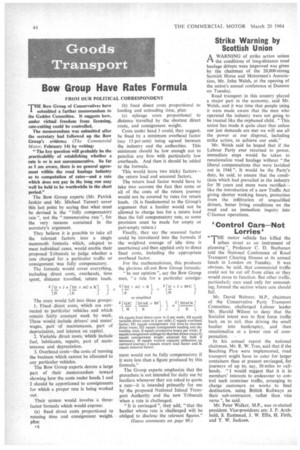Bow Group Have Rates Formula
Page 46

If you've noticed an error in this article please click here to report it so we can fix it.
FROM OUR POLITICAL CORRESPONDENT
r-rHE Bow Group of Conservatives have
I submitted a further memorandum to the Geddes Committee. It suggests how, under virtual freedom from licensing, rate-cutting could be controlled.
The memorandum was submitted after the secretary had followed up the Bow Group's evidence (The Commercial Motor, February 14) by writing:
"The key question will probably be the practicability of establishing whether a rate is or is not unremunerative. So far as I am aware, there is no general agreement within the road haulage industry as to computation of rates—and a rate which does not pay in the long run may well be held to be worthwhile in the short period."
The Bow Group experts (Mr. Patrick Jenkin and Mr. Michael Turner) cover this last point by saying that what must be devised is the "fully compensatory rate ", not the "remunerative rate ", for the very reasons contained in the secretary's argument.
They believe it is possible to take all the relevant factors into a single mammoth formula which, adapted to meet individual cases, would enable their proposed Tribunals to judge whether a rate charged for a particular traffic or consignment was fully compensatory.
The formula would cover everything, including direct costs, overheads, time spent, distance travelled, return loads.
L{G x{131 x AC x K}
The costs would fall into three groups: 1. Fixed direct costs, which are connected to particular vehicles and which remain fairly constant week by week. These would include drivers' and mates' wages, part of maintenance, part of depreciation, and interest on capital.
2. Variable direct costs, which include fuel, lubricants, repairs, part of maintenance and depreciation.
3. Overhead costs—the costs of running the business which cannot be allocated to any particular vehicles.
The Bow Group experts devote a large part of their memorandum toward showing how the costs under heads 1 and 2 should be apportioned to consignments for which a proper rate is being worked out.
Their system would involve a threefactor formula which would express: (a) fixed direct costs proportional to running time and consignment weight. plus: T6 (b) fixed disect costs proportional to loading and unloading time, plus: (c) mileage costs proportional to distance travelled by the shortest direct route, and consignment weight.
Costs under head 3 could, they suggest, be fixed by a minimum overhead factor (say 15 per cent) being agreed between the industry and the authorities. This minimum should be low enough not to penalize any firm with particularly low overheads. And then it should be added to the formula.
This would leave two tricky factors— the return load and seasonal factors.
The return load factor would have to take into account the fact that some or all of the costs of the return journey would not be covered by rates for return loads. (It is fundamental to the Group's argument that a haulier would not be allowed to charge less for a return load than the full compensatory rate, so some provision must be made for empty or part-empty return.) Finally, they say the seasonal factor could be introduced into the formula if the weighted average of idle time is ascertained and then applied only to direct fixed costs, including the appropriate overhead factor.
For the mathematicians, this produces the glorious all-out Bow Group formula: "In our opinion ", say the Bow Group men, "a rate for a particular consign ment would not be fully compensatory if it were less than a figure produced by this formula."
The Group experts emphasize that the procedure is not intended for daily use by hauliers whenever they are asked to quote a rate—it is intended primarily for use by the proposed National Inland Transport Authority and the new Tribunals when a rate is challenged.
"It is envisaged ", they add, "that the haulier whose rate is challenged will be obliged to disclose the relevant figures." (Janus comments on page 90.)
















































































































































